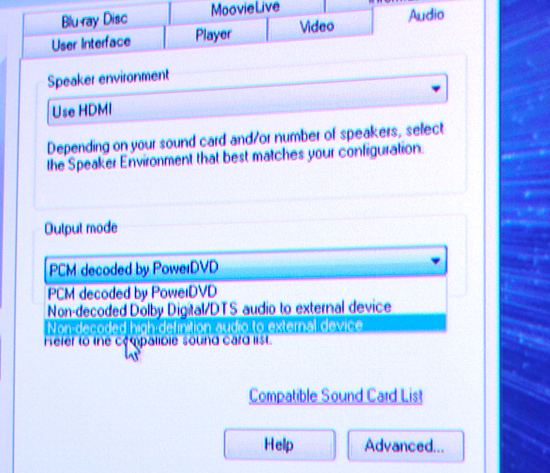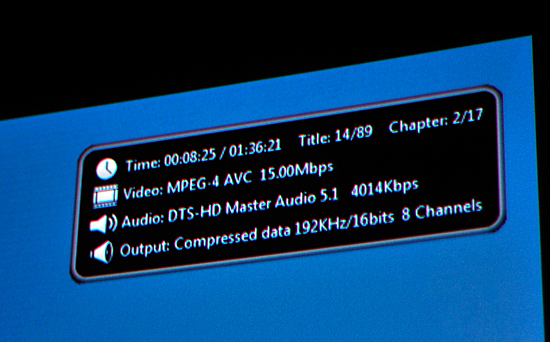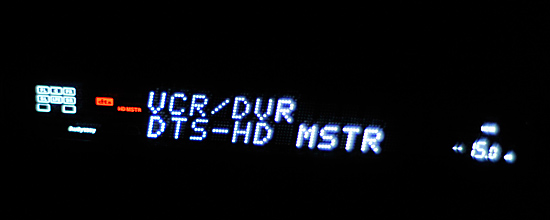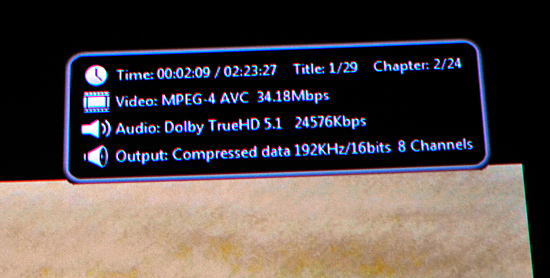AMD's Radeon HD 5870: Bringing About the Next Generation Of GPUs
by Ryan Smith on September 23, 2009 9:00 AM EST- Posted in
- GPUs
The Race is Over: 8-channel LPCM, TrueHD & DTS-HD MA Bitstreaming
It's now been over a year since I first explained the horrible state of Blu-ray audio on the PC. I'm not talking about music discs, but rather the audio component of any Blu-ray movie. It boils down to this: without an expensive sound card it's impossible to send compressed Dolby TrueHD or DTS-HD Master Audio streams from your HTPC to an AV receiver or pre-processor. Thankfully AMD, Intel and later NVIDIA gave us a stopgap solution that allowed HTPCs, when equipped with the right IGP/GPU, to decode those high-definition audio streams and send them uncompressed over HDMI. The feature is commonly known as 8-channel LPCM support and without it all high end HTPC users would be forced into spending another $150 - $250 on a sound card like the Auzentech HomeTheater HD I just recently reviewed.
For a while I'd heard that ATI was dropping 8-channel LPCM support from RV870 because of cost issues. Thankfully, those rumors turned out to be completely untrue. Not only does the Radeon HD 5870 support 8-channel LPCM output over HDMI like its predecessor, but it can now also bitstream Dolby TrueHD and DTS-HD MA. It is the first and only video card to be able to do this, but I expect others to follow over the next year.
The Radeon HD 5870 is first and foremost a card for gamers, so unless you're building a dual-purpose HTPC, this isn't the one you're going to want to use. If you can wait, the smaller derivatives of the RV870 core will also have bitstreaming support for TrueHD/DTS-HD MA. If you can't and have a deep enough HTPC case, the 5870 will work.
In addition to full bitstreaming support, the 5870 also features ATI's UVD2 (Universal Video Decoder). The engine allows for complete hardware offload of all H.264, MPEG-2 and VC1 decoding. There haven't been many changes to the UVD2 engine; you can still run all of the color adjusting post-processing effects and accelerate a maximum of two 1080p streams at the same time.
ATI claims that the GPU now supports Blu-ray playback/acceleration in Aero mode, but I found that in my testing the UI still defaulted to basic mode.
To take advantage of the 5870's bitstreaming support I had to use a pre-release version of Cyberlink's PowerDVD 9. The public version of the software should be out in another week or so. To enable TrueHD/DTS-HD MA bitstreaming you have to select the "Non-decoded high-definition audio to external device" option in the audio settings panel:

With that selected the player won't attempt to decode any audio but rather pass the encoded stream over HDMI to your receiver. In this case I had an Integra DTC-9.8 on the other end of the cable and my first test was Bolt, a DTS-HD MA title. Much to my amazement, it worked on the first try:

No HDPC errors, no strange player issues, nothing - it just worked.

Next up was Dolby TrueHD. I tried American History X first but the best I could get out of it was Dolby Digital. I swapped in Transformers and found the same. This ended up being an issue with the early PowerDVD 9 build, similar to issues with the version of the player needed for the Auzentech HomeTheater HD. Switching audio output modes a couple of times seemed to fix the problem, I now had both DTS-HD MA and Dolby TrueHD bitstreaming from the Radeon HD 5870 to my receiver.


One strange artifact during my testing was the 5870 apparently delivered 1080i output to my JVC RS2 projector. I'm not exactly sure what went wrong here as 1080p wasn't an issue on any other display I used. I ran out of time before I could figure out the cause of the problem but I expect it's an early compatibility issue.


I can't begin to express how relieving it is to finally have GPUs that implement a protected audio path capable of handling these overly encrypted audio streams. Within a year everything from high end GPUs to chipsets with integrated graphics will have this functionality.










327 Comments
View All Comments
silverblue - Saturday, September 26, 2009 - link
I think you may have been much happier with a 512-bit interface which would result in nearly 2.5x the bandwidth of the 4890, however it remains to be seen whether it'd be a waste or not. Having said that, it could mean for slower GDDR5 thus reducing costs, but wouldn't it be far more problematic to incorporate the wider bus anyway?If ATI throw out such a card with a single GPU on it, a direct comparison with the 5870 (and nVidia's top cards at the time) will be inevitable. The extra bandwidth may be rather under-utilised for anything less than Eyefinity gaming or Crysis at max details ;)
Now all we need is AMD to come back at Intel with a domestic release of its Thuban die (or hurry up with Bulldozer, sheesh) and it'll be a very, very exciting time for people to upgrade.
SiliconDoc - Sunday, September 27, 2009 - link
I want to know how the pinout compares on the 5870 gpu to the 4870/90.Have they doubled the data pins, or is the data jamming in and jamming out, even at 4800mhz ?
Maybe that's why 512bit would help.
Perhaps faster data rate ram, needs also a wider data path, more pins, more paths in and out of the gpu.
I will check the overclock sites that have already posted on this matter.
JarredWalton - Sunday, September 27, 2009 - link
I would assume that the pin count on 5870 isn't radically different from 4870. Granted, we know what assuming can get you, but with the same interface width there's not much reason for it to get substantially more pins. A few changes for power leads to deal with having more transistors, and other minor tweaks are likely, but my bet would be it's within 10% of the pin count of 4870.PorscheRacer - Monday, September 28, 2009 - link
For all those people clamoring on about why ATI didn't go with a 512-bit memory controller I'm going to chime in here with some ATI 512-bit experience. If you're a sharp one reading this, you have already guessed that means I'm going to talk about the R600. Now you can hate the card all you want, but I quite enjoyed this card. First of all, in the R600 it was the last ring-bus. It was a true 512-bit, and large memory controller. I'm not certain on the amount, but I believe it owned about a quarter of the realstate on the die. That's a lot. It also was some of the cause for the chip running hot and why UVD was scrapped from that chip to save room.Now, to keep that 512-bit ring-bus fed, you needed to push large amounts of data to it. The more you increased system bandwidth, the faster the card would be in any task. I've run hundreds of benchmarks over the years and I'm pretty sure Jared and Anand can attest to this. Same goes for overclocking the card. Raising the core didn't do much, but cranking up the VRAM to feed that hungry ring-bus sure did. Prices anyone? I believe $450 and up depending on where you were located. It was on heck of a pricey chip for ATI to make. Enter the die shrunk 3000 series with the 256-bit memory controller and voila. A cheaper chip to make. It never came close to the theoretical performance of the 2900XT, but the 3870 was about 90% of the performance for a lot cheaper. Yeas I know the cores were tweaked and so on in the 3000 series, but they are very similar.
If ATI ever went to a 512-bit bus, which means more PCB layers, higher cost in manufacturing and a larger die, I'd think they'd do it on something like Juniper or wait till 32nm. It's not feasible right now. They technically could go the MCM route with Juniper and get a mashed up version of a 512-bit bus, but I don't think the chips have been designed with that in mind.
Anyways, most computers out there are starved to feed something like the 5870 and higher cards with a 512-bit bus. I just replaced my R600 with an RV740 (hah, went from 80nm to 40nm) and now I don't need to OC the heck out of my bus to keep the card fed. I'm running an old FX-60 setup due to a glowing review on here back in early 2006. Am I the norm? NO, I'm waiting to upgrade. Is the Core i7 9xx the norm? No. You have to build a card to a certain set of people. I'm building my pal a new computer and he's happy with the 5850. The 5870 is overkill for him. It's 80% of the 5870 but a hundred bucks cheaper. Now, I'm sure ATI looked at the 512-bit bus in much the same way. "Wow, that 512-bit bus sure flies, look at those numbers! Oh, it's going to cost us this much die space and more manufacturing costs.... Well, those 256-bit bus numbers are still pretty imperssive and within 80% of the gaming benchmark scores, so we'll go that way"
Or something along those lines....I'm sure that's why nVIDIA's GTX300 is delayed. It's a massive chip, 512-bit bus and so on. Great, they'll take the performance crown again. Will they take my money? If they have something in the $200-$300 range, they have a fighting chance, just like ATI does, or soon to be Intel. Best price for performance will win me over there. I don't care what the bus size is, or how the card could have been better, just as long as I'm happy with the performance for my money. In which case, I'll be here looking forward to a GPU roundoup in the best bang for buck in that price range. Of course it will have DX11, or else there's no point in me upgrading again.
SiliconDoc - Wednesday, September 30, 2009 - link
The GT200 is a 512 bit bus.All the whining and complaining about difficulty means NOTHING.
ati goes the cheapskate sloppy lame route, cooks their cores, has 90C heat, few extra features, and a red raging fanbase filled with repeated tantric lies.
I even posted their own forum here with their 4850 90C+ whines, after some rooster told me his worst fan in the world on his 4850 kept it in the cool 60's like the several Nvidia cards, of course.
The 512bit HD2900 XTX was and is a great card, and even the 256 version still holds it's own. It was well over 500 bucks, was limited production, sold out quickly, and there was HD2900 512bit lesser version that could be flashed to full XTX with a bios upgrade, and it disappeared after it went well over $500.
That HD2900XTX has 115GB bandwidth.
It was REAL competition for the 8800GTX.
--
Of course ati cheaped out on producing any decent quantity, has been losing money, overcharged for it (and got it - but apparently like RUIZ, the "leadership" qualifies for "MORONS!"
---
Now, we'll hear endless crying about expense, about 512bit, and endless crying about core size (nvidia's giant monster), then we'll hear how ati just kicks butt because more dies to a wafer, and they can make a profit, and they can then wipe out nvidia and make them lose money....
BUT JUST THE OPPOSITE HAS BEEN GOING ON FOR SOME NUMBER OF YEARS IN A ROW.
If ati is so pathetic it can't handle making 512bit and selling 512bit, well then , they're PATHETIC.
And, yes, it seems they are PATHETIC.
Someone ought to let ati know there's "competition" and the "competition" pumps out 512bit buses all the time.
I guess when ati "finally catches up to the modern world" they can put out a 512bit again.
In the mean time, they can stick with their cheap pcb with less layers, their cooking hot crammed full electromigration core, and have a bunch of looners that for the very first time in their lives, actually believe that the ghetto is better than Beverly Hills, because they goin fps shootin', man.
Oh, it's so very nice so many gamers have as advice and worry ati's imbalanced sheet and how they can maintain it at a higher level. Such a concern on their minds, a great excuse for why ati cheaps out. I've never seen so many gaming enthusiasts with so much whoring for a company's bottom line. At the same time, nvidia is seen as an evil profit center that throws money around influencing the game production industry. LOL
Yes, it's evil for big green to make money, employ reps, toss millions into game channels, be extremely flexible and pump out 20 differing flavors of cards, so it's not so boring, work so games run well on their product - yes what evil , evil ****rds.
...
Perhaps the little red brokers could cheer some more when they feel ati "has improved it bottom line" by producing a cheap, knocked down, thinner, smaller, hotter, less featured, more negative driver issues, red card, because gamers are so concerned with economics, that they love the billions dollar losers plotted and carried out plans, and hate the company rolling in dollars and helping pump out games and a huge variety of gaming cards...
LOL
Yeah, the last red card that really was worth something, the HD2900512XTX.
That's the other thing that is so funny from these little broker economy whizzes. After they start yakkin about ati's dirt cheap product scheme, it really burns em up that the real cadillac of videocards commands a higher price.
Well, there's a reason a better made, more expensive process, more featured, wider supported in games videocard, is higher priced.
"the great economists" then suddenly turn into raging little angry reds, screeching scalping and unfair and greedy... LOL
Oh it's a hoot.
Zak - Monday, October 5, 2009 - link
I like Nvidia cards too, but if I was a moderator here you'd be banned by now. Relax. Take a pill. No one takes you seriously any more.Z.
SiliconDoc - Saturday, September 26, 2009 - link
The core clock is not doubled, still 850.The memory data rate is not doubled 3600 to 4800.
The bus width is not doubled still 256.
The frame buffer is not doubled, still 1GB
--- From Article Page 1 below ---
" So what’s Cypress in a nutshell? It’s a RV790 (Radeon HD 4890) with virtually everything doubled,.."
---
Ok, so pay attention to the word "virtually".
JarredWalton - Saturday, September 26, 2009 - link
There's no need to double the bus... either double the RAM data rate or double the bus width and you accomplish the same thing. But in a nutshell, everything is doubled relative to HD 4890 except for bandwidth, which only improves by 23%. Similarly, everything is more than double the 4870X2, you don't even need to deal with CrossFire stuff, but the 4870X2 has 50% more total bandwidth.ATI almost certainly isn't completely bandwidth limited with 4890/4870X2, but I think 5870 might just be fast enough that it's running into bandwidth limitations. On the other hand, bandwidth limitations are largely dependent on the game and algorithm. For instance, the Quake/Quake World/Doom games have been extremely bandwidth intensive in the past, and some of the titles Anand tested fall into that category. However, I know of other games that appear to be far less dependent on bandwidth, and the more programmable stuff going on, the more important shader performance becomes.
In the past, Oblivion was a great example of this. NVIDIA's 7800/7900 cards had a lot of bandwidth relative to shader performance, while ATI went the other route. Oblivion was really a strong ATI title (X1800/X1900 series) up until NVIDIA released 8800, which greatly improved NVIDIA's shader performance. Most modern titles tend to be a combination of things.
SiliconDoc - Sunday, September 27, 2009 - link
Note: Edited for ease of response.Well noone makes double the ram data rate, there is NO SUCH DDR5. (No one ever said there was.)
None of it runs at 7200 for videocards.
NVIDIA is using the 512bit bus and 448bit+ on it's top cards, so what is ATI's problem, when that's the only thing available ? (They don't need it enough to increase the cost of the cards to get it.)
Furthermore, the core is still 850, so have the data pins in and out of the core doubled ? I RATHER DOUBT IT. (Obviously it didn't - the specs say it's 256-bit. Did you not read the post?)
So, concievably, we have twice the data to move, on the same core speed, with less than double the DATA PINS in and out. (No, we don't have twice the data to move, unless the 4890 totally maxed out what the RAM could provide. ATI doesn't think this happened, so they only marginally increased bandwidth.)
If the bandwidth is NOT the problem, as you so claim, why then since everything ELSE you say has doubled, the conclusion we have is the ATI core is not up to the task. (If it truly had doubled in every area, and performance didn't double, we'd have a problem. The conclusion sane people will draw is that ATI looked at cost and benefit and decided a 256-bit bus was sufficient for the present. Otherwise they'd need a more complex circuit board, which would increase complexity and cost.)
That's it, it's core tech is so much the same....
LOL
Just love those ATI arguments. (There was no argument, but I'm a troll so I created one!)
When the CORE is overclocked, we will see a framerate increase.
SOOOOO.....
Tell me how the core handles TWICE THE DATA in and out - unless it's pinout count has doubled ? Is ther that much wasted time on the 4890 pins - on the current 5870 pins ? (No one said the core handles twice as much data; theoretically it can, but then deeper buffers would help.)
It may handle double data or nearly internally, but that has to communicate with the ram- etc onboard.
SORRY, once again, not agreeing. (Agreeing with what, that the bandwidth only increased by 23%? Wow, that's amazing. You'd disagree if someone said the sun rises in the east, wouldn't you? Try reading next time before responding instead of arguing for the sake of argument.)
Zool - Sunday, September 27, 2009 - link
The meaning of cache on the gpu is so it doesnt need to read and write to dram memmory too often. The speed of texture cache on 5870 is 1 TB/sec and its sram. And thats just the texture chache. It just shows how much speed is needed to utilize that raw comuting power on the chip. They surely tested the chip with higher speed memory and ended with this bandwith compromis.Also u cant compare the bare peak bandwith. The type of memmory controler and the speed of the GPU(and also cache) should change the real world bandwith like we see with wideferent CPU models and speeds.
When u read xxx GB/s bandwith it doesnt mean it always this fast (they name it peak bandwith always).